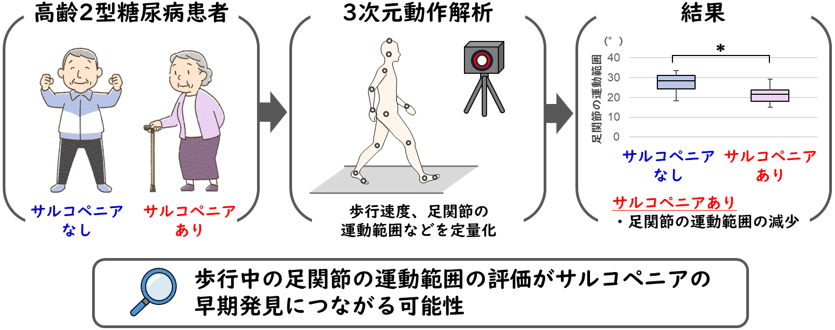2025-05-27 産業技術総合研究所
 高齢2型糖尿病患者におけるサルコペニアの有無による歩行特徴を定量化
高齢2型糖尿病患者におけるサルコペニアの有無による歩行特徴を定量化
※原論文の一部の図を引用・改変したものを使用(ライセンス:CC BY 4.0)
<関連情報>
- https://www.aist.go.jp/aist_j/press_release/pr2025/pr20250527/pr20250527.html
- https://www.nature.com/articles/s41598-025-00205-0
サルコペニアの有無にかかわらず2型糖尿病高齢者における時空間および運動学的歩行特性 Spatiotemporal and kinematic gait characteristics in older patients with type 2 diabetes mellitus with and without sarcopenia
Tomotaka Manabe,Wakako Tsuchida,Toshihiro Kobayashi,Masahiro Fujimoto,Takuma Inai,Kohei Kido,Shoma Kudo,Kensaku Fukunaga,Takanobu Saheki,Takafumi Yoshimura,Hitomi Imachi & Koji Murao
Scientific Reports Published:27 May 2025
DOI:https://doi.org/10.1038/s41598-025-00205-0
Abstract
To investigate the differences in gait characteristics between older patients with type 2 diabetes with and without sarcopenia, using a three-dimensional motion analysis system. This cross-sectional study included 38 patients with type 2 diabetes aged ≥ 65 years and capable of independently performing activities of daily living. Participants’ demographic data, spatiotemporal gait parameters, and ranges of motion of the pelvis, hip, knee, and ankle joints during a gait cycle were collected. The participants were classified into sarcopenic (n = 15) and non-sarcopenic (n = 23) groups and compared. Significant reductions in walking speed, shorter stride lengths, longer stride time, stance and double support times, and decreased cadence were observed in participants with sarcopenia. In addition, participants with sarcopenia exhibited a significantly smaller range of motion for ankle joint plantar dorsiflexion. In patients with type 2 diabetes, gait characteristics differ depending on the presence or absence of sarcopenia. These findings may contribute to the development of new qualitative assessment methods to facilitate the timely detection of sarcopenia in this patient population.


